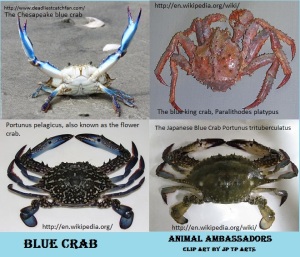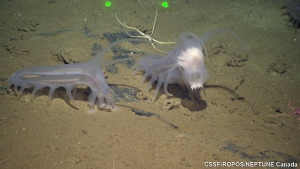
Blue crab
The Chesapeake blue crab or Atlantic blue crab, Callinectes sapidus
The blue swimmer crab, Portunus pelagicus
The blue king crab, Paralithodes platypus
The Japanese blue crab, Portunus trituberculatus
The blue crab is so named because of its sapphire-tinted claws. Its shell, or carapace, is actually a mottled brownish color, and mature females have red highlights on the tips of their pincers. Prized by humans for their sweet, tender meat, these wide-ranging, ten-legged crustaceans are among the most heavily harvested creatures on the planet. Their scientific name, Callinectes sapidus, means “savory beautiful swimmer.”
Blue crabs are found in brackish coastal lagoons and estuaries from Nova Scotia, through the Gulf of Mexico, and as far south as Uruguay. Close relatives of the shrimp and lobster, these bottom-dwelling omnivores have a prickly disposition and are quick to use their sharp front pincers. Large males can reach 9 inches (23 centimeters) in shell width.
They feed on almost anything they can get hold of, including mussels, snails, fish, plants, and even carrion and smaller blue crabs. They are also excellent swimmers, with specially adapted hind appendages shaped like paddles.
Atlantic blue crab (Callinectes sapidus)
Atlantic blue crab, or the Chesapeake blue crab, is a species of crab native to the waters of the western Atlantic Ocean and the Gulf of Mexico, and introduced internationally. Callinectes sapidus may grow to a carapace width of 230 mm (9.1 in). It can be distinguished from a related species occurring in the same area by the number of frontal teeth on the carapace; C. sapidus has four, while C. ornatus has six
After showing signs of a big comeback, the Chesapeake Bay’s blue crab population has plunged by more than half. The results of a winter survey, released Friday, showed that crab numbers fell 61 percent, from an estimated 765 million last year to 300 million crabs in 2013 — the lowest number in five years.
Virginia and Maryland have been working hard to bring crabs back, and largely succeeding, since the population nearly crashed in 2007, prompting a federal disaster declaration. Officials called the latest findings disappointing, but they emphasized that crab numbers fluctuate a lot naturally.
Crabs responded quickly. The population jumped from an estimated 251 million in 2007 to last year’s 765 million — the highest total since the early 1990s.
Conservation efforts
Unique expertise and facilities for broodstock, hatchery and juvenile production of blue crabs. ARC is a 1,800-square-meter, state-of-the-art, environmentally responsible marine core facility that operates on recirculating artificial seawater. The Gulf Coast Marine Life Center will implement and build upon their infrastructure and technologies to successfully mass-produce blue crab juveniles for stock enhancement efforts along the Gulf coast region. The University of Maryland (ARC) has published abundant amount of information on the effective stock enhancement, including releasing large batches of individually tagged juvenile hatchery crab and monitoring them through DNA fingerprinting as well as developing optimal release strategies. Studies leading to a better understanding of the Blue Crab biology and life cycle are helping wildlife officials develop new policies for managing this economically vital fishery.
University of Maryland Institute of Marine and Environmental Technology’s Aquaculture Research Center (ARC
The blue swimmer crab, Portunus pelagicus
Portunus pelagicus, also known as the flower crab, blue crab, blue swimmer crab, blue manna crab or sand crab, and alimasag in Tagalog, is a large crab found in the intertidal estuaries of the Indian and Pacific Oceans (Asian coasts) and the Middle-Eastern coast of the Mediterranean Sea. The name “flower crab” is used in east Asian countries while the latter names are used in Australia. The crabs are widely distributed in eastern Africa, Southeast Asia, East Asia, Australia, Persian Gulf and New Zealand. The males are bright blue in colour with white spots and with characteristically long chelipeds, while the females have a duller green/brown, with a more rounded carapace. The carapace can be up to 20 centimetres (7.9 in) wide.
They stay buried under sand or mud most of the time, particularly during the daytime and winter, which may explain their high tolerance to ammonium (NH4+) and ammonia (NH3). They come out to feed during high tide on various organisms such as bivalves, fish and, to a lesser extent, macroalgae. They are excellent swimmers, largely due to a pair of flattened legs that resemble paddles. However, in contrast to another portunid crab (Scylla serrata), they cannot survive for long periods out of the water.
- pelagicus commonly enters estuaries for food and shelter. Its life cycle is dependent on estuaries as the larvae and early juveniles use these habitats for growth and development. Prior to hatching, the female moves into shallow marine habitats, releases her eggs and the newly hatched zoea I larvae move into estuaries. During this time they feed on microscopic plankton and progress from the zoea I stage to the zoea IV stage (approximately 8 days) and then to the final larval stage of megalopa (duration of 4–6 days). This larval stage is characterised by having large chelipeds used to catch prey. Once the megalopa metamorphoses to the crab stage they continue to spend time in estuaries which provides a suitable habitat for shelter and food. However, evidence has shown that early juveniles cannot tolerate low salinities for extended periods, which is likely due to its weak hyper-osmoregulatory abilities. This may explain their mass emigration from estuaries to seawater during the rainy season. Male Portunus pelagicus are believed to become more territorial in colder water. This may explain why male crabs are rarely sighted within a close proximity to each other in more temperate waters; it also may explain why their female counterparts seem more prolific in these such areas.
The blue king crab Paralithodes platypus
Species of king crab which lives near St. Matthew Island, the Pribilof Islands, and the Diomede Islands, Alaska, with further populations along the coasts of Japan and Russia. Blue king crabs from the Pribilof Islands are the largest of all the king crabs, sometimes exceeding 18 pounds (8.2 kg) in weight.
Commercial blue king crab harvest around the eastern Bering Sea began in the mid-1960s and peaked in 1981 with a catch of 13,228,000 pounds (6,000 t). The Pribilof Island harvest by the United States peaked in 1980 at 10,935,000 lb (4,960 t) and was closed in 1988 due to population decline, then again in 1999 after being opened for three years. The St. Matthew fishery peaked in 1983 with 9,453,500 lb (4,288.0 t) but experienced a similar decline and was closed in 1999. It was opened in 2009, and was featured on the television show Deadliest Catch. The St. Matthew stock is rebuilding but the fishery remains closed, while the Pribilof stock has not drastically improved. Diomede blue king crabs have never been harvested commercially, but support a subsistence fishery for the Native Village of Diomede, Alaska, population 170.
Colder water slows the rate of crab growth and crabs at northern latitudes are often smaller than more southern crabs. Commercial harvest of blue king crabs at the Pribilof Islands is limited to males with a carapace width (CW) over 6.5 inches (170 mm) and St. Matthew Island is limited to crabs with CW greater than 5.5 in (140 mm), corresponding to crabs over 4.7 in (120 mm) carapace length (CL). Diomede blue king crabs are similar in size to St. Matthew Island crabs.
Pribilof Island blue king crabs mate and produce eggs in late March to early May. Females generally brood their eggs externally for 12–14 months. Since blue king crabs need more than a year to brood their eggs, they miss a breeding cycle just before the larvae hatch and only produce eggs every other year, although first-time breeders can often produce eggs in subsequent years. Females release larvae around the middle of April in the Pribilof Islands, while those held at warmer temperatures in the laboratory may release larvae as early as February.
Female blue king crabs in the Pribilof Islands grow to the largest size before they are reproductively mature. About 50% of crabs are mature at 5 in (130 mm) CL. St. Matthew Island females can become sexually mature at 3 in (76 mm) CL and Diomede crabs are similar. Larger female crabs from the Pribilof Islands have the highest fecundity, producing 162,360 eggs or 110,033 larvae per crab. The reduction in fecundity is about 33% between the egg and larval stages. In Japan, an average of 120,000 larvae were released from each blue king crab. Diomede blue king crabs release an average of 60,000 larvae per female.
Environmental variables, such as tides, temperature, salinity, light, phytoplankton blooms, and predation, are seasonally pulsed and likely serve as cues for larval release. Release of larvae over a longer period may serve to give the female a larger window for larvae to correspond with any favorable environmental conditions that may exist, also known as “bet-hedging”. In the laboratory, Pribilof larvae hatch over the course of about one month, and Diomede larvae hatch over the course of 2–3 weeks. These differences may be due to water temperature in the laboratory, which has a clear effect on embryonic and larval development, and is probably slightly different from hatch timing in a natural environment.
The Japanese blue crab, Portunus trituberculatus
Portunus trituberculatus, the gazami crab, Japanese blue crab or horse crab, is the most widely fished species of crab in the world. It is found off the coasts of East Asia and is closely related to Portunus pelagicus.
The carapace may reach 15 centimetres (5.9 in) wide, and 7 cm (2.8 in) from front to back. P. trituberculatus may be distinguished from the closely related (and also widely fished) P. pelagicus by the number of broad teeth on the front of the carapace (3 in P. trituberculatus, 4 in P. pelagicus) and on the inner margin of the merus (4 in P. trituberculatus, 3 in P. pelagicus). Carapace rough to granulose with regions discernible. Front with 3 acutely triangular teeth with the central projected slightly forwards of the lateral ones; 9 teeeth on each anterolateral margin, the most external one much larger than the preceding. Chelipeds elongate: larger chelae with conical tooth at the base of fingers; 4 spines on the inner margin of the merus. Legs laterally flattened to variyng degrees, last 2 segments of last pair paddle-like. Carapace colour dull green to brown.
- trituberculatus is the world’s most heavily fished crab species, with over 300,000 tonnes being caught annually, 98% of it off the coast of China.
Sources
http://www.nationalgeographic.com/
http://www.gcmlc.com/index.php
http://www.fao.org/fi/website/FIRetrieveAction.do?dom=topic&fid=3380&lang=en
Photo credit
http://en.wikipedia.org/wiki/







